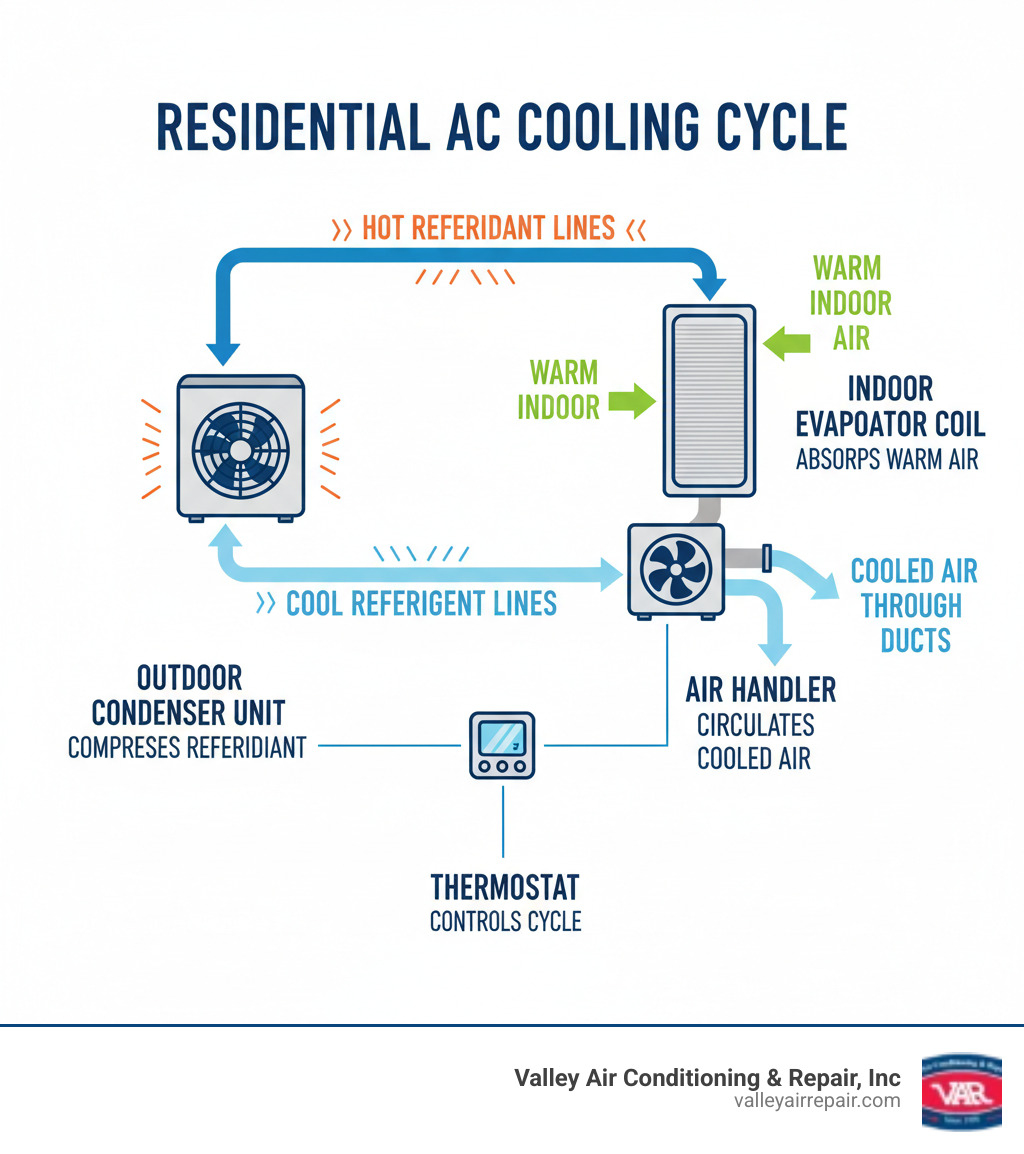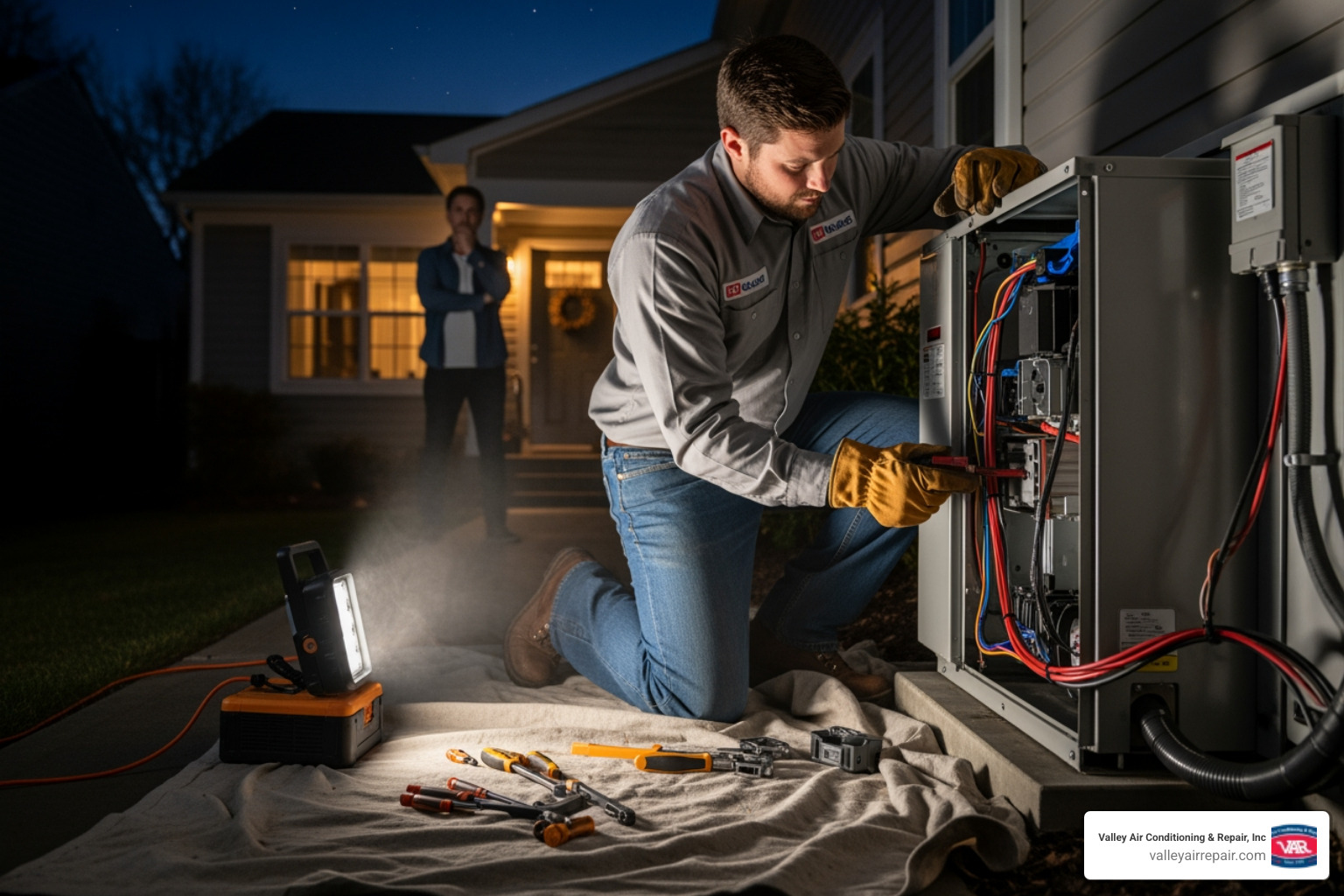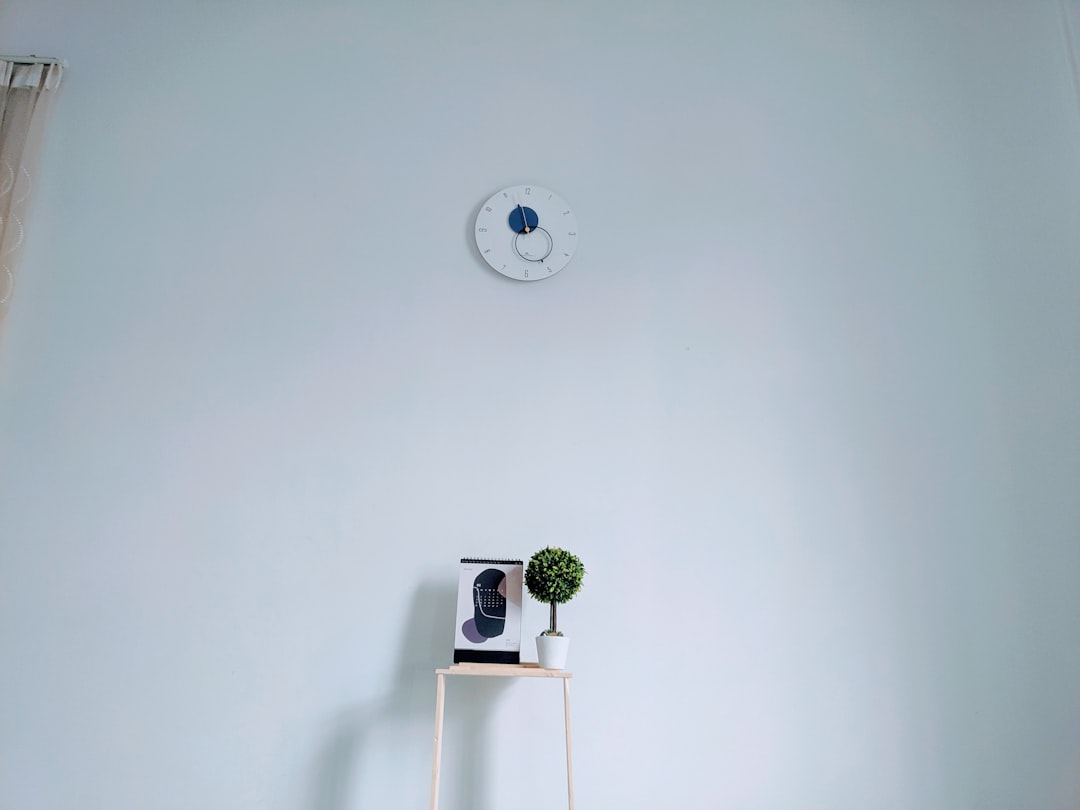Home AC Installation Made Easy: A Comprehensive How-To

Why Home Air Conditioning Installation Matters
Residential AC installation is the process of selecting, sizing, and professionally setting up a complete air conditioning system for your home. It involves choosing the right system type, performing load calculations for proper sizing, and ensuring a professional installation that covers everything from ductwork to electrical connections and final testing.
In the Valley, a reliable air conditioning system is essential for comfort and well-being during sweltering summers. Getting your AC installation right the first time makes all the difference. A properly installed system not only cools your home but also improves indoor air quality, removes humidity, and can last 15 to 20 years with regular maintenance. In contrast, a rushed or improper installation can lead to inefficient cooling, higher energy bills, and costly repairs.
This guide covers everything you need to know about home AC installation, from choosing the right system to maximizing its efficiency and lifespan. Understanding the process will help you make informed decisions, whether you're building a new home, replacing an old unit, or upgrading to a more efficient system.

Choosing the Right AC System for Your Home
When it comes to Residential AC installation, understanding your options is the first step. Modern air conditioning technology offers several systems designed for different home layouts and cooling needs.

- Central air systems are the most popular choice for whole-home cooling. They use a network of ducts to deliver cooled air from a single outdoor unit paired with an indoor air handler. If you already have ductwork, central AC is often the most cost-effective and efficient option.
- Ductless mini-split systems offer flexibility, connecting an outdoor compressor to one or more indoor air handlers without needing ductwork. They are an ideal solution for homes without existing ducts, for room additions, or for creating specific cooling zones.
- Packaged units combine all components into a single outdoor cabinet. They are less common residentially but can be installed on rooftops or concrete slabs, connecting directly to the home's ductwork.
Beyond cooling, central AC systems improve your home environment by circulating air through filters that capture dust and allergens. They also reduce humidity, which helps prevent mildew and protects your home from moisture damage. If your current system is old, our guide on the Benefits of Upgrading Your Aging HVAC System explains why a new, efficient system is a worthwhile investment.
How to Determine the Right Size and Type
Properly sizing your AC unit is critical. An undersized unit will run constantly without effectively cooling your home, leading to high energy bills and premature wear. An oversized unit will cool the space too quickly, cycling on and off before it can adequately remove humidity, leaving your home feeling clammy.
A qualified contractor will perform an ACCA Manual J load calculation, the industry standard recommended by the Air Conditioning Contractors of America. This detailed assessment considers your home's insulation, windows, ceiling heights, climate, and other factors to determine the precise cooling load. AC units are measured in "tons" (1 ton = 12,000 BTUs). While there are rough guidelines, a professional calculation is necessary to account for our intense Valley heat and ensure your unit is sized perfectly for your home.
Understanding Energy Efficiency and Modern Features
Once you know the right size, consider the features that impact efficiency. The SEER (Seasonal Energy Efficiency Ratio) rating measures how much cooling you get for the energy consumed. Higher ratings mean better efficiency and lower energy bills. Units with the ENERGY STAR certification are significantly more efficient than older models. While high-efficiency units have a higher upfront cost, they provide long-term savings on energy consumption.
Modern compressor technology also plays a key role:
- Single-stage compressors are either on or off, found in basic units (13-14 SEER).
- Dual-stage compressors have two levels (e.g., 70% and 100%), offering better temperature and humidity control (16-18 SEER).
- Variable-speed compressors adjust capacity continuously, providing the quietest operation, most stable temperatures, and highest efficiency (18+ SEER).
Pairing your system with a smart thermostat can further reduce cooling costs by about 10%.
Solutions for Residential AC Installation in Homes Without Ductwork
No ductwork? No problem. Ductless mini-split systems are an excellent solution. They use refrigerant lines to connect an outdoor unit to one or more indoor air handlers, each cooling a specific zone. Installation is less invasive than adding traditional ductwork, making them perfect for older homes or additions. High-velocity systems, which use small, flexible tubes, are another alternative that is easier to install in existing walls than traditional ducts. Both options provide targeted cooling with less disruption. For more details, explore our Residential Air Conditioning Services.
Understanding Your AC System: Key Components
To appreciate your new Residential AC installation, it helps to know the main parts. Most homes have a split central AC system, with equipment divided between an outdoor and an indoor unit.

The outdoor unit (condenser unit) houses the condenser coil, which releases heat absorbed from your home; the compressor, which pumps refrigerant through the system; and a fan that helps dissipate the heat.
The indoor unit, located in an attic, basement, or closet, contains the evaporator coil, where refrigerant absorbs heat from your indoor air. The air handler (or furnace blower) then pushes the newly cooled air through the house.
Refrigerant lines are copper tubes that carry refrigerant between the indoor and outdoor units, creating a continuous heat transfer loop.
Ductwork is the distribution network that carries cool air to each room and returns warmer air to the indoor unit.
The thermostat is the command center, mounted on an interior wall, where you set your desired temperature and control the system.
Each of these components works in harmony to create a comfortable indoor environment. Understanding their roles can help you recognize when your system might need professional attention.
Preparing Your Home for a Smooth Installation
A little preparation can ensure your Residential AC installation goes smoothly. Key areas to consider are your ductwork, unit placement, and electrical system.
Ductwork Evaluation
For a central AC system, your ductwork is the delivery network for cool air. A pre-installation inspection is crucial. Leaky ducts can waste up to 30% of your cooled air, so sealing leaks with mastic sealant is a vital step. We also check for proper insulation, especially in unconditioned spaces like attics, to prevent energy loss.
If your home needs new ductwork, we will design a layout with the shortest, straightest runs possible to ensure even airflow and maximize efficiency.
Unit Placement
Proper placement of AC components affects efficiency and longevity. The outdoor unit (condenser) should be in a shaded spot if possible, as direct sunlight forces it to work harder. It also needs at least 2 feet of clearance for airflow and service access. We install it on a stable, level concrete pad to prevent vibration and settling.
The indoor unit should be in an accessible location like an attic, basement, or utility closet, away from heat-generating appliances that could interfere with its sensors.
Electrical Requirements
Modern AC systems require sufficient power. We will assess your home's electrical panel to verify it can handle the new unit's demands. In some cases, an electrical upgrade may be necessary for safety and to prevent tripped breakers or equipment damage. Ensuring the electrical system is adequate protects your home and your investment.
Best Time of Year for Installation
The best time for a Residential AC installation is during the milder spring or fall months. During these off-peak seasons, scheduling is often more flexible, and our teams can work more efficiently in comfortable temperatures. You may also find better pricing and rebates. Most importantly, a proactive installation means you won't be left without AC during an unexpected summer heatwave. Planning your HVAC System Upgrade during these times is a smart strategy.
The Professional Residential AC Installation Process
Once you've chosen your system and prepared your home, the professional Residential AC installation begins. This is where expertise makes a critical difference.

Professional vs DIY Benefits
While DIY projects can be satisfying, Residential AC installation is a job for professionals. The key reasons are:
- Safety: Technicians are trained to handle high-voltage electrical wiring and refrigerants, which can be dangerous without proper knowledge and equipment.
- Specialized Tools: Proper installation requires tools like manifold gauges, vacuum pumps, and torque wrenches that are not standard for homeowners.
- Efficiency: Professionals follow manufacturer specifications precisely, ensuring your unit operates at peak efficiency and keeps energy bills low.
- Warranty Protection: Most manufacturers will void the warranty if the unit is not installed by a licensed professional. We protect your manufacturer's warranty and provide our own labor warranty for added peace of mind.
Standard Installation Steps
Our team follows a proven process for every Residential AC installation:
- Site Preparation and Old Unit Removal: We prepare the installation area and, if applicable, safely disconnect and remove your old unit, properly recovering and disposing of any refrigerant according to federal regulations.
- New Unit Installation: The indoor air handler and outdoor condenser are mounted in their designated locations, ensuring they are level and secure.
- Electrical and Refrigerant Connections: We run refrigerant lines between the units, brazing connections to be leak-free. Electrical wiring is installed to code, connecting the units to your home's power and thermostat. A condensate drain line is also installed to remove moisture.
- System Charging and Testing: The system is charged with the exact amount of refrigerant specified by the manufacturer. We then test the system thoroughly, verifying airflow, cooling efficiency, and the function of all components.
- Final Inspection and Walkthrough: We conduct a final check and walk you through how to operate your new system, explaining basic maintenance like filter changes. For a deeper look at our process, see our AC Installation Fresno Complete Guide.
Key Factors in Your Residential AC Installation
A straightforward central AC replacement typically takes 4 to 8 hours. More complex projects, such as those requiring new ductwork or electrical upgrades, may take longer. The complexity of the system (e.g., a multi-zone ductless system vs. a standard central AC) also affects the timeline.
Your investment is protected by two types of warranties: a manufacturer's warranty on parts (typically 5-10 years) and our labor warranty on the installation itself. Understanding these coverages provides important peace of mind. We are proud to offer exceptional Air Conditioning Services in Fresno, CA that meet the highest standards.
After Installation: Maximizing Efficiency and Lifespan
Congratulations! Your new Residential AC installation is complete, but proper care is needed to ensure it delivers peak performance for years to come.
System Lifespan
A well-maintained central AC unit typically lasts 15 to 20 years. However, without regular professional maintenance, that lifespan can be cut nearly in half. Consistent care is the key to protecting your investment.
Maximizing Efficiency
Keeping your system running efficiently is straightforward with a few simple habits:
- Use a Programmable Thermostat: Automating temperature adjustments can reduce cooling costs by about 10%. Set it to use less energy when you're away or asleep.
- Change Filters Regularly: A clean filter allows your system to breathe easily, improving efficiency and air quality. Check your filter every 1-3 months, especially if you have pets or allergies.
- Keep the Outdoor Unit Clear: Ensure at least two feet of clearance around your outdoor condenser. Remove leaves, grass, and other debris that can obstruct airflow and force the unit to work harder.
Professional Maintenance Benefits
While homeowner maintenance is important, there is no substitute for an annual professional tune-up. During a maintenance visit, our technicians perform a comprehensive health check: inspecting and cleaning coils, checking refrigerant levels, lubricating moving parts, tightening electrical connections, and verifying overall performance.
This preventative care catches small issues before they become major, expensive problems. It's a small investment that pays dividends in efficiency, reliability, and longevity. Learn more about keeping your system in top shape on our HVAC System Maintenance page.
Frequently Asked Questions about Home AC Installation
Here are answers to some of the most common questions homeowners have about Residential AC installation.
How long does a central AC unit typically last?
A well-maintained central AC unit can be expected to last 15 to 20 years. The key to achieving this lifespan is consistent, annual professional maintenance. These tune-ups catch small issues before they become major problems, ensuring your system runs efficiently for as long as possible.
What does the SEER rating mean for an AC unit?
SEER stands for Seasonal Energy Efficiency Ratio. It measures an AC unit's cooling output over a season divided by the energy it consumes. Think of it like MPG for a car—a higher SEER rating means greater energy efficiency and lower electricity bills. Upgrading from an older, lower SEER unit to a modern, high-efficiency model can result in significant savings.
Can central air conditioning improve my home's air quality?
Yes. As your central AC system circulates air, it passes through filters that capture dust, pollen, pet dander, and other airborne particles. This filtration process can significantly improve indoor air quality, which is especially beneficial for those with allergies or respiratory issues. Central AC also controls humidity, removing excess moisture from the air to help prevent the growth of mold and mildew.
Your Partner for a Cool and Comfortable Home
You've made it through the complete journey of Residential AC installation. Armed with this knowledge, you're ready to make informed decisions that will keep your family comfortable through every Valley summer.
The truth is, a successful installation comes down to three things: choosing the right system for your specific needs, properly preparing your home, and working with professionals who genuinely care about doing the job right. When these pieces come together, you get more than just cool air—you get peace of mind, lower energy bills, and a system that faithfully serves your family year after year.
For homeowners in the Valley, finding a team you can trust makes all the difference. Since 1970, Valley Air Conditioning & Repair, Inc. has built our reputation one satisfied customer at a time, through word-of-mouth and a simple commitment: treat every home like it's our own. We don't chase the latest marketing trends or make promises we can't keep. Instead, we focus on quality workmanship, honest advice, and being there when you need us most.
Whether you're replacing an aging system, upgrading to a more efficient model, or installing AC in a new construction, our experienced technicians bring over five decades of expertise to every project. We understand the unique challenges of cooling homes in our climate, and we take the time to ensure your Residential AC installation is done right the first time.
Ready to take the next step toward a cooler, more comfortable home? We're here to help with expert guidance custom to your specific situation. Explore our HVAC installation services in Fresno, CA to learn more about how we can make your home the oasis you deserve.




.webp)










